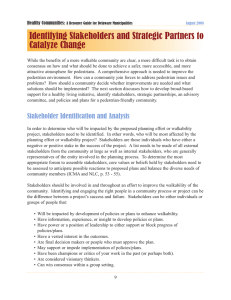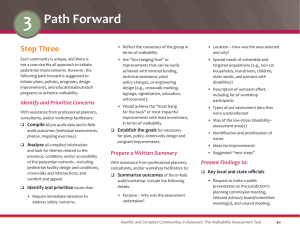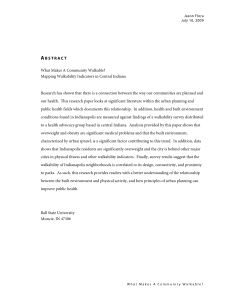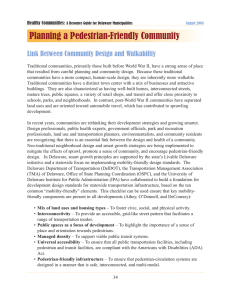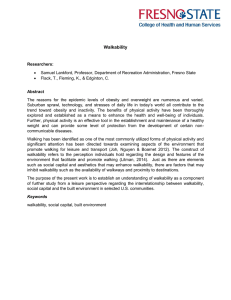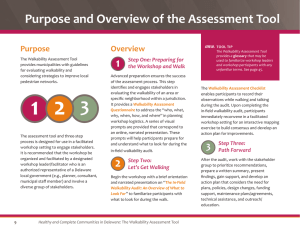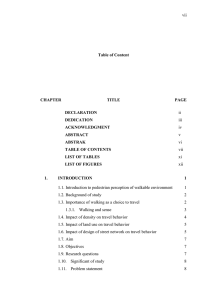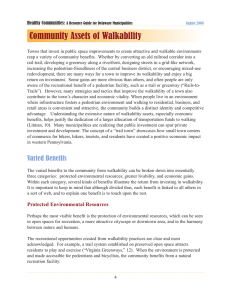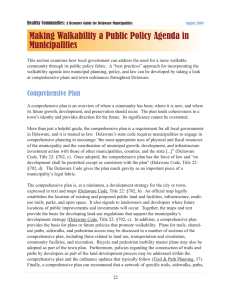Healthy Communities:
advertisement
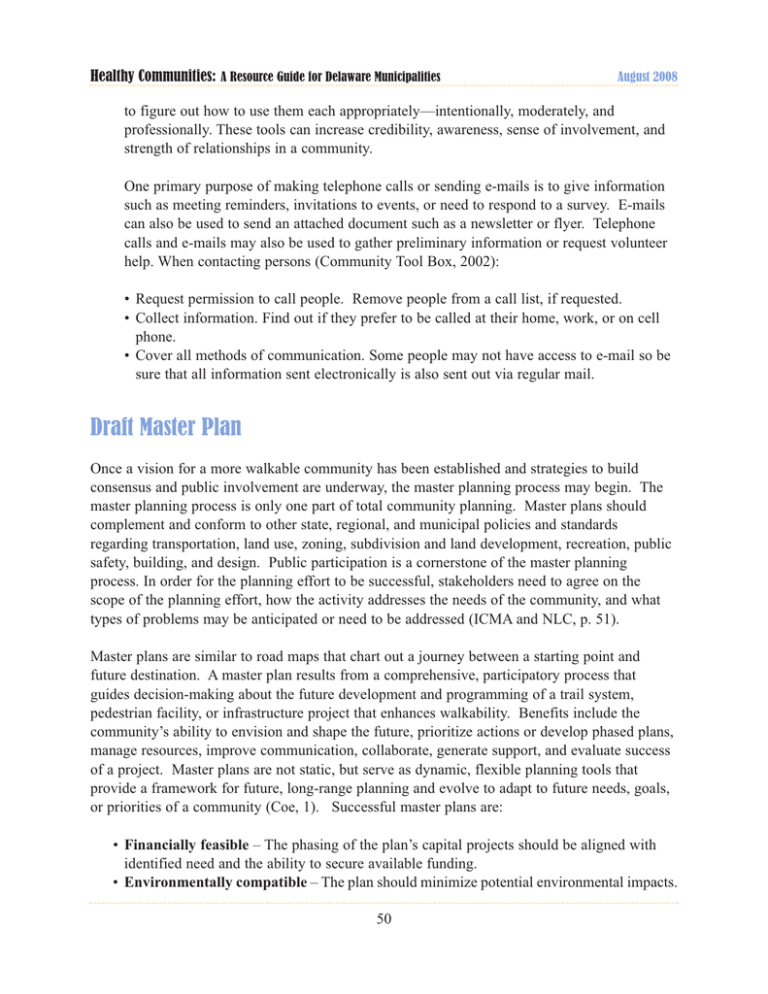
Healthy Communities: A Resource Guide for Delaware Municipalities August 2008 to figure out how to use them each appropriately—intentionally, moderately, and professionally. These tools can increase credibility, awareness, sense of involvement, and strength of relationships in a community. One primary purpose of making telephone calls or sending e-mails is to give information such as meeting reminders, invitations to events, or need to respond to a survey. E-mails can also be used to send an attached document such as a newsletter or flyer. Telephone calls and e-mails may also be used to gather preliminary information or request volunteer help. When contacting persons (Community Tool Box, 2002): • Request permission to call people. Remove people from a call list, if requested. • Collect information. Find out if they prefer to be called at their home, work, or on cell phone. • Cover all methods of communication. Some people may not have access to e-mail so be sure that all information sent electronically is also sent out via regular mail. Draft Master Plan Once a vision for a more walkable community has been established and strategies to build consensus and public involvement are underway, the master planning process may begin. The master planning process is only one part of total community planning. Master plans should complement and conform to other state, regional, and municipal policies and standards regarding transportation, land use, zoning, subdivision and land development, recreation, public safety, building, and design. Public participation is a cornerstone of the master planning process. In order for the planning effort to be successful, stakeholders need to agree on the scope of the planning effort, how the activity addresses the needs of the community, and what types of problems may be anticipated or need to be addressed (ICMA and NLC, p. 51). Master plans are similar to road maps that chart out a journey between a starting point and future destination. A master plan results from a comprehensive, participatory process that guides decision-making about the future development and programming of a trail system, pedestrian facility, or infrastructure project that enhances walkability. Benefits include the community’s ability to envision and shape the future, prioritize actions or develop phased plans, manage resources, improve communication, collaborate, generate support, and evaluate success of a project. Master plans are not static, but serve as dynamic, flexible planning tools that provide a framework for future, long-range planning and evolve to adapt to future needs, goals, or priorities of a community (Coe, 1). Successful master plans are: • Financially feasible – The phasing of the plan’s capital projects should be aligned with identified need and the ability to secure available funding. • Environmentally compatible – The plan should minimize potential environmental impacts. 50 Healthy Communities: A Resource Guide for Delaware Municipalities August 2008 • Balanced – The plan should maintain a balance between community needs and community impacts. • Technically sound – The plan should comply with federal, state, and local requirements and it should be able to be constructed efficiently and cost effectively. • Responsive – The plan should address the needs and interests of stakeholders. • Flexible – The plan should be dynamic and able to respond to future changing conditions. Master Plan Components A master plan for a new public park, trail, shared-use path, streetscape project, or infrastructure project that supports walkability integrates both strategic and physical development planning. A consulting firm may be hired by a municipality to guide the master planning process with oversight from an advisory committee and considerable public input. While there is no prescribed format, the document may consist of sections that describe the background of the project, existing site conditions, the community’s vision, design considerations and requirements, funding needs, and maintenance requirements. At this stage, the master plan is conceptual in nature and is subject to public review and refinement based on input. The draft is not intended to address detailed issues related to engineered site design or operational aspects. These issues are deferred to the project development process. The following checklist describes elements of a master plan: • Background and existing conditions – This section reflects outcomes of the data collection phase, which may include: • • • • • • Base mapping using geographic information systems (GIS). Site description and analysis. Survey data. Needs assessment for the facility or project. Analysis of consistency with existing plans, policies, and statutes. Description of the community’s demographics, physical characteristics, pedestrian. circulation system and/or trail network. • Inventory of existing facilities. • Results of walkability audits. • Community vision – This section of the master plan should express the community’s vision, goals and objectives for achieving the vision, and a prioritized action plan to guide attainment of the vision. Also described in this section is the public outreach process, list of stakeholders, types of public outreach efforts and meetings, and attendees at each venue. Outcomes of the visioning process should identify community issues, opportunities and constraints, and other considerations that may impact the planning process. 51 Healthy Communities: A Resource Guide for Delaware Municipalities August 2008 • Draft master plan – The draft master plan should have both a written narrative component, which describes a general management plan, and a conceptual development plan, which illustrates schematic design options for the proposed project or facility. • General management plan – The written narrative component describes: • Purpose of facility. • Types of facilities and uses. • Integration with existing pedestrian circulation systems and park facilities. • Integration with land use, water, natural resource, environmental protection, and stewardship plans. • Funding options. • Maintenance and stewardship. • Volunteer and partnership opportunities. • Conceptual development plan – Mapping scenarios should be included to provide conceptual design options that detail: • Existing and proposed phases. • Future pedestrian network connections and trail linkages. • Facility design considerations and development standards governing universal design, accessibility, maintenance and sustainability, security, and management. • Points of interest. Develop Implementation Plan Following community input, extensive fieldwork, research into related planning endeavors, and a site analysis, the draft master plan will undergo an extensive public review process. Ideally, the draft master plan will have several opportunities for public review, in accordance with FOIA, prior to adoption. A public meeting or series of neighborhood forums may occur at the onset of the planning process to introduce the project, explain the purpose of the project, review site conditions, identify community issues, clarify the planning process, and highlight opportunities for public review. After a conceptual development plan with various design options is prepared, a public workshop or informal open house may be held to enable the public to evaluate alternatives and provide feedback. After each public meeting, the draft master plan may be further refined. The final master plan will be presented at a final public hearing and be subject to a public comment period prior to the final approval and adoption of the plan. An implementation plan should be developed based on funding, priorities, and planned phases of development. Many small municipalities, which do not have an engineer on staff, must hire an engineering firm to develop and prepare an implementation plan. This plan will consist of preliminary engineering plans, design guidelines, and cost estimates for the project. Financial resources necessary for implementation will be identified. Finally, a management plan may be prepared internally by the responsible departments (e.g., Parks and Recreation, Public Works, 52 Healthy Communities: A Resource Guide for Delaware Municipalities August 2008 and Police) to detail operations and maintenance requirements once the project is constructed, describe operational policies and standards, identify safety and security issues, plan education and stewardship activities, and organize future recreation programming activities. Adopt Plan After the master plan is adopted, the development process begins. Development or construction of a project to enhance the walkability of a community may not immediately follow adoption of the master plan. Funding sources must be identified, which often requires the lengthy process of applying for grants, securing voter-approved bonds, obtaining private contributions, and/or budgeting for municipal capital improvement funds. Once funding is secured, the budget will determine if phased construction is required and the scope of work for the first phase of the project. Following plan adoption and budget approval, the contracted engineering firm may be authorized to prepare detailed engineered site designs, bid documents (drawings and specifications), and a request for proposals (RFP) to bid the construction project. The RFP will be advertised for a competitive bidding process and the contract will be awarded if all bid specifications are met. The construction process begins once all applicable permits have been secured and project documentation requirements have been met. 53
